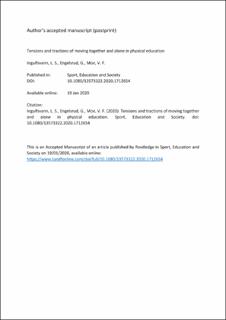Tensions and tractions of moving together and alone in physical education
Peer reviewed, Journal article
Accepted version
Permanent lenke
https://hdl.handle.net/11250/2719099Utgivelsesdato
2020Metadata
Vis full innførselSamlinger
Originalversjon
Ingulfsvann, L. S., Engelsrud, G., Moe, V. F. (2020). Tensions and tractions of moving together and alone in physical education. Sport, Education and Society. doi: 10.1080/13573322.2020.1712654Sammendrag
A wide variety of activities, instructional teaching styles and physical activity for health characterise PE practices today. However, for children, PE is about more than performing activities or being physically active for health. Children experience moving in the context of PE in varying and ambivalent ways, which indicates that qualitative aspects of movement (how to move) and the movement context (where to move and with whom) matter to them. To gain understanding of movement qualities in PE and PE as a movement context, this article explores what happens with and between children when they move in PE and how children’s movements and interactions relate to the context in which they move. The analysis starts with observational material from four primary schools in western Norway and an affect theoretical perspective is used. Through an in-depth analysis of 10–11-year-old children playing a game of sheep and wolverines, the article demonstrates how multiple actions and multiple dimensions of movement emerge simultaneously and how children’s own movements and the activity emerge and develop through reciprocal interactions. The activity framework forms how children move or is expected to move, while children’s actual movements make the activity what it is. Playing together co-exists and alternates with playing alone and playing in multiple ways. The flux of the game involves both an opportunity for something different to the present moment to become and for the accumulation of permanent patterns. The findings indicate a need to further discuss and explore the balances and imbalances between the individuals and the collective and the individuals, descriptions, rules and instructions in the context of PE.
